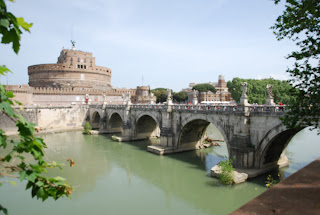On our stroll home, we walked by Trajan’s column, done in 113 A.D. to commemorate Emperor Trajan’s victory over the Dacians; its spiral bas relief shows scenes from the conflict. It was originally topped with a statue of Trajan, but that disappeared in the Middle Ages and in 1587, Pope Sixtus decided a statue of St. Peter would fill the gap nicely.
Rome is still alive, however, in the manhole covers, which sport SPQR (Senātus Populusque Rōmānus ("The Senate and People of Rome”), dating from 80 B.C. and still in use by the commune of Rome.
St. Peter’s has a new CEO, so the lines were horrendous when we arrived (and the square in front set up with a sea of folding chairs for some scheduled event, so we gave it a miss, other than taking a couple of photos.
Strolling back toward the Tiber River, we encountered the Castel Sant’Angelo, built between 130 and 139 A.D. as a mausoleum for Emperor Hadrian; it served as the final resting place for a number of other emperors, the last being the seriously unpleasant Caracalla. Hadrian also built the Pons Aelius, the bridge that connects Castel Sant’Angelo with the right bank.
Rome is still alive, however, in the manhole covers, which sport SPQR (Senātus Populusque Rōmānus ("The Senate and People of Rome”), dating from 80 B.C. and still in use by the commune of Rome.
St. Peter’s has a new CEO, so the lines were horrendous when we arrived (and the square in front set up with a sea of folding chairs for some scheduled event, so we gave it a miss, other than taking a couple of photos.
Strolling back toward the Tiber River, we encountered the Castel Sant’Angelo, built between 130 and 139 A.D. as a mausoleum for Emperor Hadrian; it served as the final resting place for a number of other emperors, the last being the seriously unpleasant Caracalla. Hadrian also built the Pons Aelius, the bridge that connects Castel Sant’Angelo with the right bank.








No comments:
Post a Comment